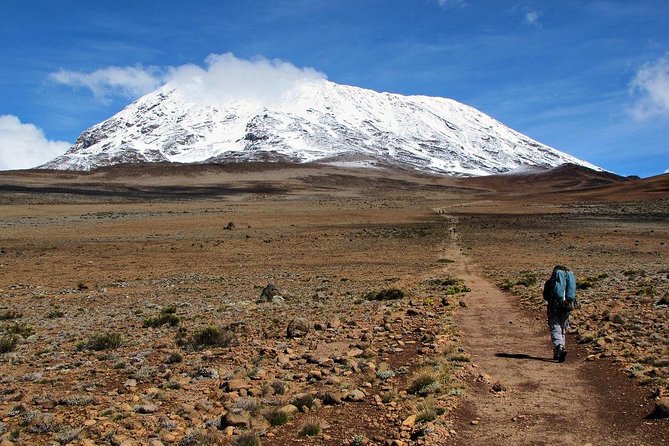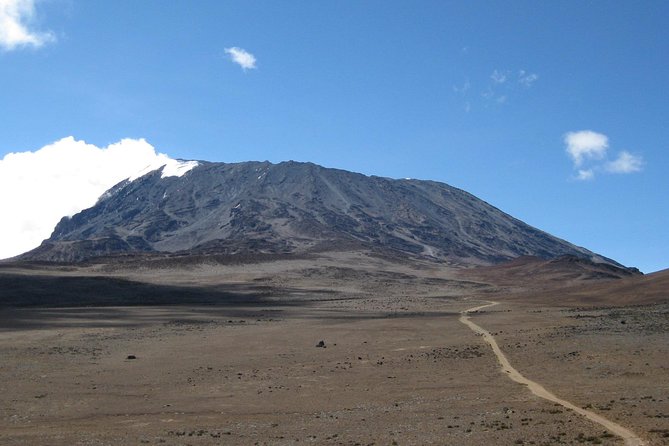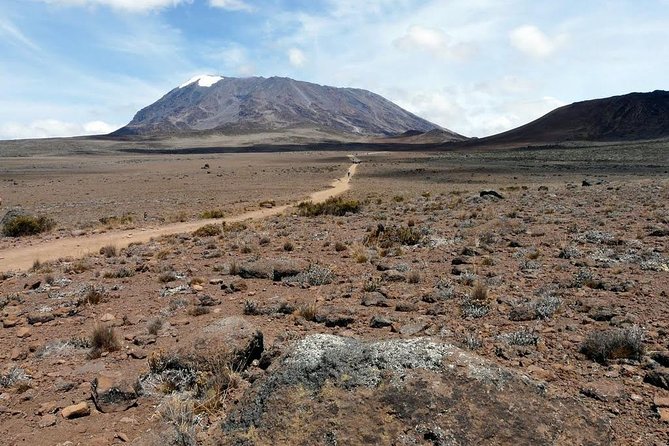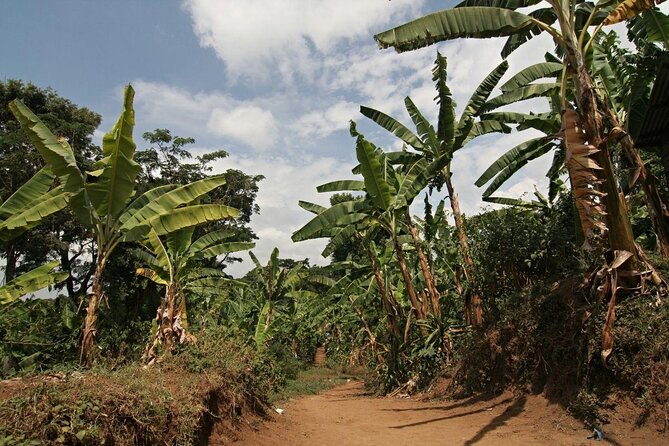The allure of Kilimanjaro’s Marangu Route lies in its accessibility and well-developed infrastructure, making it a popular choice for trekkers seeking an adventurous yet comfortable journey to Africa’s highest peak. This five-day ascent promises an immersive experience, where hikers can traverse diverse landscapes, from lush rainforests to barren alpine zones, while enjoying the camaraderie of communal dining and sleeping in cozy huts. However, conquering Kilimanjaro requires thorough preparation and a keen understanding of the unique challenges this remarkable mountain presents. With the right mindset and a spirit of exploration, trekkers embark on a transformative journey that could leave a lasting impression.
Key Points

- The Marangu Route, known as the "Coca-Cola" route, offers a gradual ascent to Kilimanjaro’s summit with a total elevation gain of nearly 13,000 feet.
- Proper preparation, including warm layers, sturdy boots, trekking poles, and acclimatization to high altitude, is crucial for the safety and success of the trek.
- The diverse landscapes encountered during the trek include rainforest, moorland, alpine, and the summit, each with its unique flora and fauna.
- The camping experience along the Marangu Route is enhanced by comfortable tents, a centralized mess tent, and the assistance of professional guides and porters.
- The rich biodiversity of the Kilimanjaro ecosystem, including Senecio trees, giant groundsels, colobus monkeys, and other wildlife, contributes to the overall trekking adventure.
Discovering the Marangu Route

The Marangu Route, often dubbed the "Coca-Cola" route, provides a relatively gradual ascent up the slopes of Kilimanjaro.
This popular path is known for its well-developed infrastructure, including huts for sleeping, which makes it an attractive choice for trekkers. The route follows the southeastern side of the mountain, offering stunning views of the surrounding landscape.
While considered a more accessible option, the Marangu Route still presents a significant physical challenge, with hikers ascending nearly 13,000 feet over the course of the 5-day trek.
Despite its popularity, this route remains a thrilling and rewarding way to conquer the highest peak in Africa.
Here are more great tours and experiences we've reviewed in Arusha
Preparing for the Trek

Preparing for the trek on the Marangu Route requires thorough planning and packing. Climbers must ensure they’ve the proper gear, including warm layers, sturdy hiking boots, and trekking poles.
Plus, they’ll need to pack essential items like water bottles, snacks, and personal medications. The trek’s high altitude poses unique challenges, so climbers should acclimate gradually and stay hydrated.
Three key considerations are:
- Packing the right equipment
- Preparing for altitude adjustments
- Maintaining proper hydration and nutrition
With careful preparation, hikers can embark on the Marangu Route trek with confidence, ready to conquer the iconic Mount Kilimanjaro.

On the Marangu Route, hikers traverse diverse landscapes that showcase the natural splendor of Mount Kilimanjaro. The trek begins in lush, verdant rainforests, then progresses through moorland and alpine meadows, before reaching the barren, rocky terrain of the summit. Along the way, trekkers are treated to stunning vistas of distant peaks, glaciers, and valleys. To help navigate this ever-changing landscape, the following table outlines the key features encountered on the Marangu Route:
| Terrain | Elevation | Vegetation | Wildlife |
|---|---|---|---|
| Rainforest | 1,800-2,700 m | Lush, verdant | Monkeys, birds |
| Moorland | 2,700-3,700 m | Heath, shrubs | Eland, buffalo |
| Alpine | 3,700-4,700 m | Sparse, rocky | None |
| Summit | 5,895 m | Barren, snowy | None |
Camping on the Mountain
Amidst the rugged terrain of Mount Kilimanjaro, trekkers find solace in the comfortable camping experience provided on the Marangu Route.
Equipped with high-quality tents, sleeping mats, and cooking gear, the camping setup ensures a restful respite after each day’s challenging hike.
The centralized mess tent serves as a communal gathering space, fostering camaraderie among fellow adventurers.
On top of that, the presence of a professional guide and porters to assist with camp setup and meal preparation allows trekkers to fully enjoy the stunning natural surroundings.
The Marangu Route’s camping amenities elevate the overall Kilimanjaro experience, making it a truly memorable journey.
- Comfortable, high-quality camping equipment
- Centralized mess tent for communal dining
- Professional support staff to assist with camp setup and meals
Encountering Wildlife and Flora
As trekkers ascend the slopes of Mount Kilimanjaro, they’re greeted by a diverse array of captivating flora and fauna. From the lush rainforests at the base to the alpine deserts near the summit, the mountain boasts an incredible variety of plant and animal life. Hikers may spot towering Senecio trees, vibrant wildflowers, and the iconic giant groundsels. In terms of wildlife, they may encounter troops of colobus monkeys, klipspringers, and even the elusive leopard. The table below outlines some of the most notable species found along the Marangu Route.
| Flora | Fauna |
|---|---|
| Senecio trees | Colobus monkeys |
| Giant groundsels | Klipspringers |
| Wildflowers | Leopards |
| Heather | Buffalos |
| Mosses | Zebras |
Ready to hit more trails? More hiking adventures we feature in Arusha
Reaching the Summit
The final leg of the Marangu Route to the summit of Kilimanjaro tests the endurance and determination of even the most seasoned trekkers.
The steady ascent becomes increasingly challenging as the air grows thinner and the terrain steeper. Yet for those who persevere, the reward is nothing short of breathtaking. The panoramic views from the summit are truly awe-inspiring, offering a glimpse of Tanzania’s diverse landscapes.
The journey to the top is a testament to the human spirit, requiring:
- Unwavering mental fortitude
- Physical resilience
- Teamwork and support from fellow trekkers
Reaching the summit of Kilimanjaro is an unforgettable achievement that will leave a lasting impression on all who dare to make the climb.
Descending the Mountain
Descending the mountain is a crucial phase of the Kilimanjaro trek, one that demands just as much endurance and caution as the ascent. Trekkers must navigate the steep, rocky terrain with care, as the descent can be equally taxing on the body.
The route back down is often quicker, taking approximately 2-3 days. Hikers should maintain a steady pace, rest frequently, and stay hydrated to minimize the risk of injury or fatigue. The final stretch to the base camp is a welcome relief, marking the successful completion of the arduous journey.
Throughout the descent, trekkers are accompanied by the experienced guides, who ensure the group’s safety and well-being.
Post-Trek Experiences
Upon completing the descent, trekkers can look forward to the post-trek experiences that cap off their Kilimanjaro adventure.
The tour includes accommodation before and after the trek, allowing participants to rest and reflect on their accomplishments.
Returning to Arusha, the jumping-off point for the expedition, trekkers can:
- Celebrate their achievement with a well-deserved meal and drinks.
- Explore the local culture and markets of Arusha.
- Arrange for additional safari or cultural experiences in Tanzania.
These post-trek experiences provide a fitting conclusion to the Kilimanjaro challenge, leaving trekkers with a sense of pride and lasting memories.
Frequently Asked Questions
What Is the Group Size for This Tour?
This tour is a private activity, so only your group participates. The group size is not specified, but it’s a private tour, so the size is determined by you and your party.
Are There Any Age Restrictions for Participants?
The tour does not have any age restrictions, as it is suitable for most travelers. However, it’s important to note that the trek can be physically demanding, so participants should be in good physical condition to safely complete the climb.
Can I Bring My Own Camping Gear and Equipment?
While the tour includes camping equipment, participants are welcome to bring their own gear if preferred. The provider allows for this flexibility to ensure a comfortable experience for all trekkers.
Is There an Option to Start the Trek at a Different Time?
The tour operates with a start time of 1:30 am. However, travelers may be able to arrange a different start time by contacting the tour operator, Mafie Adventures, to discuss their preferences and availability.
How Often Are the Meals Provided During the Trek?
According to the tour overview, meals are included 4 times for breakfast, 5 times for lunch, and 4 times for dinner during the trek. The tour provides a comprehensive meal plan to fuel participants throughout the 5-day Kilimanjaro hike.
Recap
The Marangu Route on Kilimanjaro offers trekkers an accessible and rewarding adventure. With its well-developed infrastructure and gradual ascent, it allows for a comfortable journey through diverse landscapes. Proper preparation is key, but the opportunity to observe unique wildlife and flora, as well as the sense of achievement upon reaching the summit, make this trek a truly unforgettable experience.
More 5-Day Experiences in Arusha
More Hiking & Trekking Tours in Arusha
More Tour Reviews in Arusha
Not for you? Here's more things to do in Arusha we have recnetly reviewed
- 20 Best 2 Day Tours In Arusha
- 20 Best 3 Day Tours In Arusha
- 20 Best 4 Day Tours In Arusha
- 3 Best Food Tours In Arusha
- 4 Best Full-Day Tours In Arusha
- 21 Best Coffee Tours And Tastings In Arusha
- 5 Days Marangu Route – Mount Kilimanjaro Trek
- 7 Days Great Wildebeest Migration Mara River Crossing
- Fly Inn to Central Serengeti From Zanzibar Featuring Ngorongoro & Tarangire Park
- 5 Days Tanzania Big 5 Safaris
- Tanzania Wildlife Safari Budget Camping
- 2 Days Mid-Range Tanzania Private Safari – Tarangire & Ngorongoro
